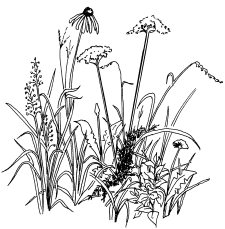
Indicator Species
Meades Milkweed: Asclepias meadii
Missouri status: Endangered
IUCN status has not been determined.
Natural history:
A member of the larger Apocynaceae family of milkweed plants. This species is native to tallgrass prairies and requires moist conditions with regular burns. A unique milkweed with yellowgreen flowers, this species serves as the host to monarch butterflies as well as several other Lepidoptera. The flowers provide nectar as well for insects and birds. Viewed as a weed by many people, this species is often sprayed with roundup and other herbicides.
Habitat:
This species is very sensitive and not found in habitats other than moist tallgrass prairie. Regular burning and/or periodic grazing reduces competition for sunlight and promotes conditions ideal for the growth of this milkweed.
Range:
http://bonap.net/MapGallery/County/Asclepias%20meadii.png
Links:
http://mdc.mo.gov/discover-nature/field-guide/mead-s-milkweed
http://www.fws.gov/Midwest/endangered/plants/meads/index.html
http://www.centerforplantconservation.org/collection/CPC_ViewProfile.asp?CPCNum=308
https://en.wikipedia.org/wiki/Asclepias_meadii
Guiding questions for predicting the future of this species at Tucker Prairie:
-
Does this species account lend evidence to support the ability to adapt to changing vegetation, soil moisture, and climate?
-
Are the habitat requirements for this species broad or specific?
-
What is your prediction for the success of this species at Tucker Prairie if climate change results in a gradual conversion of Tucker Prairie from native prairie to shrubs and eventually woodland?
-
What does this species eat? What other species eats Meade’s Milkweed?
-
Consider your answers to the previous three questions. Given the complex symbiotic relationship between host/pollinator plants and insects such as butterflies, what are some implications for the overall prairie ecosystem with a changing climate at Tucker prairie?
-
Why should we care about changes in the population of a plant like Milkweed? Socially is this important or not? Why?



